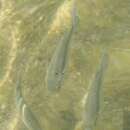Diagnostic Description
provided by Fishbase
Bluish brown or green dorsally; flanks and abdomen silvery; dusky spots on upper row of scales, giving indistinct longitudinal stripes (Ref. 9812). Dorsal and upper lobe of caudal fin with dark-blue tip. Anal, pelvic, and pectoral fins yellow. Pectorals also with dark blue spot dorsally at origin (Ref. 9812). Pectoral-fin axil scale very long.Description: Characterized by having membranous, digitate posterior margin on scales; snout shorter than eye diameter; slender maxilla and weakly curved ventrally at posterior tip, partially or completely concealed; poorly developed adipose eyelid as rim around eye; preorbital weakly concave on anteroventral edge (Ref. 90102).
Migration
provided by Fishbase
Catadromous. Migrating from freshwater to the sea to spawn, e.g., European eels. Subdivision of diadromous. Migrations should be cyclical and predictable and cover more than 100 km.
- Recorder
- Estelita Emily Capuli
Morphology
provided by Fishbase
Dorsal spines (total): 4 - 5; Dorsal soft rays (total): 8 - 9; Analspines: 3; Analsoft rays: 8 - 10
Trophic Strategy
provided by Fishbase
Inhabits coastal waters but enters estuaries and rivers. Forms schools. Feeds on microalgae, filamentous algae, forams, diatoms, and detritus associated with sand and mud.
- Recorder
- Drina Sta. Iglesia
Biology
provided by Fishbase
Inhabit coastal waters but enters estuaries and rivers where they feed on microalgae, filamentous algae, forams, diatoms, and detritus associated with sand and mud (Ref. 9812). Form schools. Oviparous, eggs are pelagic and non-adhesive (Ref. 205). Also caught using stakenets, barrier nets, and pouch nets during spawning; also taken as bycatch (Ref. 9812). Marketed fresh and perhaps salted, boiled (Thailand), canned or frozen (Australia); roe salted (Ref. 9812).
- Recorder
- Estelita Emily Capuli
Importance
provided by Fishbase
fisheries: commercial
- Recorder
- Estelita Emily Capuli
分布
provided by The Fish Database of Taiwan
分布於印度-太平洋區水域,由紅海、東非洲至馬貴斯群島,北至日本南部及夏威夷,南至澳洲及新加勒多尼亞等。臺灣四周海域除東部外均有。
利用
provided by The Fish Database of Taiwan
經濟性魚種,主要為沿岸流刺網或待袋網等法捕獲,但產量不多,且因本種魚體型較小,又沒有烏魚有飽滿的卵,故經濟價值不像烏魚來的高,魚肉適合煮湯或紅燒皆不錯。
描述
provided by The Fish Database of Taiwan
體延長呈紡綞形,前部圓形而後部側扁,背無隆脊。頭短,圓筒形。吻短;唇薄,下唇有一高聳的小丘且具有長長的、纖毛的、有間隔的唇齒,上唇則有短且分散的唇齒。眼圓,前側位;脂眼瞼不發達,僅及眼眶緣;前眼眶骨寬廣,佔滿唇和眼之間的空間,前緣有缺刻但隨著成長而變為平直。口小,前位;上頜骨末端遠於口角後緣,尖刀狀,不特別寬大,末端微彎曲向下;舌骨、鋤骨和翼骨上長牙齒,骨則無。鼻孔每側各一對。在稚魚期為圓鱗,隨著成長而變為膜性櫛鱗;頭部及體側的側線發達;側線數目12-14條;側線鱗36-42(通常為38-40);胸鰭末端前之側線鱗10-14;第二背鰭起點垂直線前之側線鱗23-26(通常為24-25);環繞尾柄上之側線鱗19-20(少數為18)。鰓耙繁密細長,第一鰓弓下枝鰓耙39-73(通常超過50)。背鰭兩個,第一背鰭硬棘IV,第二背鰭鰭條I,8;胸鰭上側位,具16-18鰭條,基部上端具黑點,腋鱗發達;腹鰭腹位,具鰭條I,5,腋鱗發達;臀鰭具鰭條III,9;尾鰭分叉;幽門垂數6-7條;具沙囊胃。新鮮標本的體背綠褐色,體側銀白色,腹部漸次轉為白色。背鰭暗色;臀鰭淡色而具暗緣;胸鰭黃色,胸鰭基部無色,但在基部的上端有一黑藍色的斑點;尾鰭淡藍黑色。以前所記載之台灣凡鯔(/Valamugil
formosae/)及薛氏凡鯔(/Valamugil seheli
/)為本種之同種異名(Nakabo, 2002)。
棲地
provided by The Fish Database of Taiwan
主要棲息於沿岸砂泥底質地形的海域,而河口區或紅樹林等半淡鹹水海域亦常見其蹤跡,亦常侵入河川下游。以底泥中有機碎屑或水層中的浮游生物為食,群棲性,常成群洄游,幼魚在受到驚嚇時,會有躍離水面的動作。
Bluespot mullet
provided by wikipedia EN
The bluespot mullet (Crenimugil seheli) is a member of the ray-finned fish family Mugilidae found worldwide in coastal temperate and tropical waters, and in some species in fresh water.[1] Crenimugil seheli have served as an important source of food in South East Asia.[2]
References

- license
- cc-by-sa-3.0
- copyright
- Wikipedia authors and editors
Bluespot mullet: Brief Summary
provided by wikipedia EN
The bluespot mullet (Crenimugil seheli) is a member of the ray-finned fish family Mugilidae found worldwide in coastal temperate and tropical waters, and in some species in fresh water. Crenimugil seheli have served as an important source of food in South East Asia.
- license
- cc-by-sa-3.0
- copyright
- Wikipedia authors and editors

